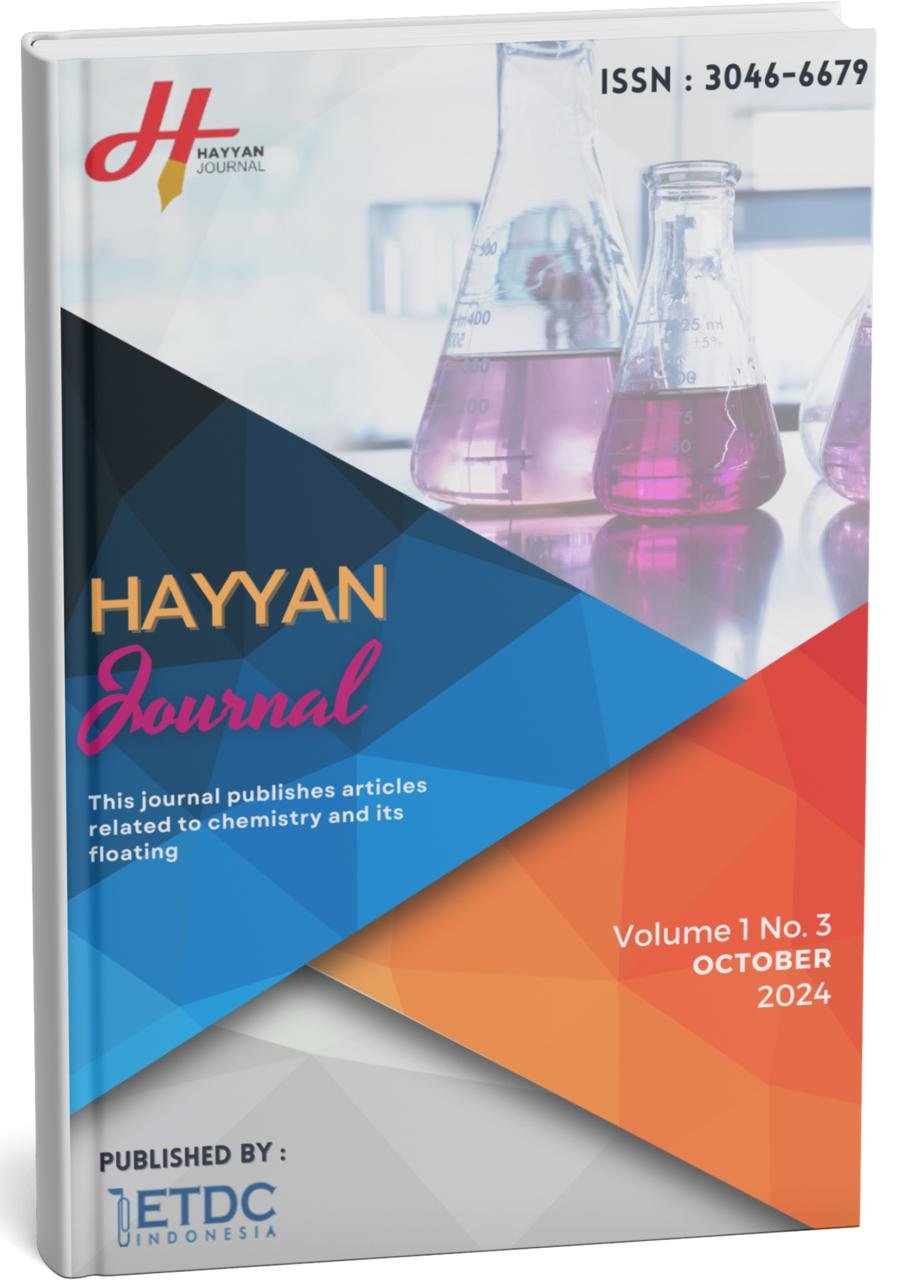Isotherm Adsorption of Cd(II) Using Surfactant-Modified Activated Carbon-Sodium Lauryl Sulfate (SMAC-SLS)
DOI:
https://doi.org/10.51574/hayyan.v1i3.2336Keywords:
Adsorption, Cd(II), SMAC-SLS, Langmuir, FreundlichAbstract
Heavy metal pollution such as Cd(II) in the environment is a serious issue that requires effective solutions. This study aims to evaluate the ability of sodium lauryl sulfate surfactant modified activated carbon (SMAC-SLS) in adsorbing Cd(II) from solution. SMAC-SLS synthesis was carried out using wet impregnation method with SLS solution. The adsorption process was tested at various concentrations of Cd(II), and the results were analyzed using Langmuir and Freundlich isotherm models. The results showed that the adsorption of Cd(II) on SMAC-SLS followed the Freundlich isotherm model, with R2 of 0.995, Kf of 1.934 mg/g, and nnn of 5.039, indicating excellent adsorption on the heterogeneous surface. The Langmuir model also gave an R2 of 0.9767 with a maximum adsorption capacity Qmax of 11.83 mg/g and adsorption energy of 22.517 kJ/mol, indicating a possible chemisorption mechanism. Modification of activated carbon with SLS was shown to increase the adsorption capacity as well as the interaction with Cd(II) ions. This suggests that SMAC-SLS has great potential as an adsorbent in the treatment of wastewater containing heavy metals.
References
Arianti, W., Pramitasari, H., & Widodo, L. (2023). Penyerapan zat warna remazol red menggunakan adsorben arang aktif batang ubi kayu. Chempro, 3(1), 14–19. https://doi.org/10.33005/chempro.v3i1.128
Arnelli, V. N. W., Fauziah, F., & Astuti, Y. (2019). Synthesis of surfactant modified activated carbon (SMAC) from rice husks as Ni(II) and Cr(VI) adsorbent. IOP Conference Series: Materials Science and Engineering, DIX(1).
Blanco, A., Monte, M. C., Campano, C., Balea, A., Merayo, N., & Negro, C. (2018). Nanocellulose for Industrial Use. In Handbook of Nanomaterials for Industrial Applications (pp. 74–126). Elsevier. https://doi.org/10.1016/B978-0-12-813351-4.00005-5
Es-said, A., Nafai, H., Lamzougui, G., Bouhaouss, A., & Bchitou, R. (2021). Comparative adsorption studies of cadmium ions on phosphogypsum and natural clay. Scientific African, XIII.
Hojabri, S., Rajic, L., Zhao, Y., & Alshawabkeh, A. N. (2024). Simulation of hexavalent chromium removal by electrocoagulation using iron anode in flow-through reactor. Journal of Hazardous Materials.
Jasim, A. Q., & Ajjam, S. K. (2024). Removal of heavy metal ions from wastewater using ion exchange resin in a batch process with kinetic isotherm. South African Journal of Chemical Engineering, ILIX, 43-54,.
Ko, Y. G. (2024). Hybrid method integrating adsorption and chemical precipitation of heavy metal ions on polymeric fiber surfaces for highly efficient water purification. Chemosphere.
Kristianto, H. (2017). Review: Sintesis karbon aktif dengan menggunakan aktivasi kimia zncl2. Jurnal Integrasi Proses, 6(3). https://doi.org/10.36055/jip.v6i3.1031
Kuang, Y., Zhang, X., & Zhou, S. (2020). Adsorption of methylene blue in water onto activated carbon by surfactant modification. Water, XII(2), 1-19,.
Lanjar, L., Riayanti, F., & Astuti, W. (2018). Kesetimbangan adsorpsi zat warna methyl violet oleh karbon aktif berbasis limbah daun nanas (ananas comosus l. Metana, 14(2), 31. https://doi.org/10.14710/metana.v14i2.20095
Mandal, S., Calderon, J., Omary, M. S. B. M. A., & Shi, S. Q. (2021). Mesoporous activated carbon as a green adsorbent for the removal of heavy metals and Congo red: Characterization, adsorption kinetics, and isotherm studies. Journal of Contaminant Hydrology, CCIVIII.
Moelyaningrum, A. (2019). Pemanfaatan arang aktif ampas kopi sebagai adsorben kadmium pada air sumur (the usage of coffee waste actived charcoal as adsorbent of cadmium in well water. Jurnal Teknologi Lingkungan Lahan Basah, 7(1), 011. https://doi.org/10.26418/jtllb.v7i1.31115


